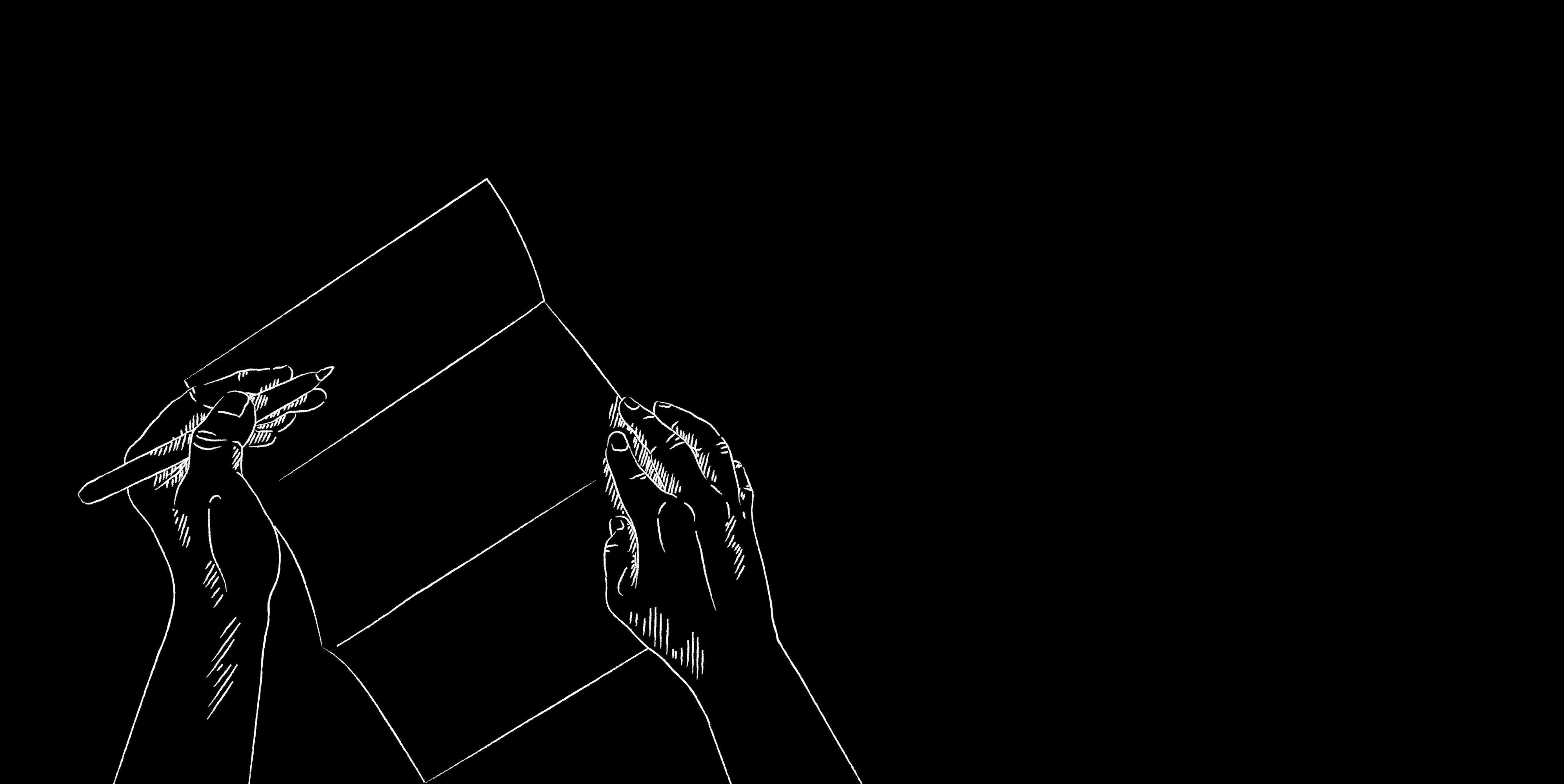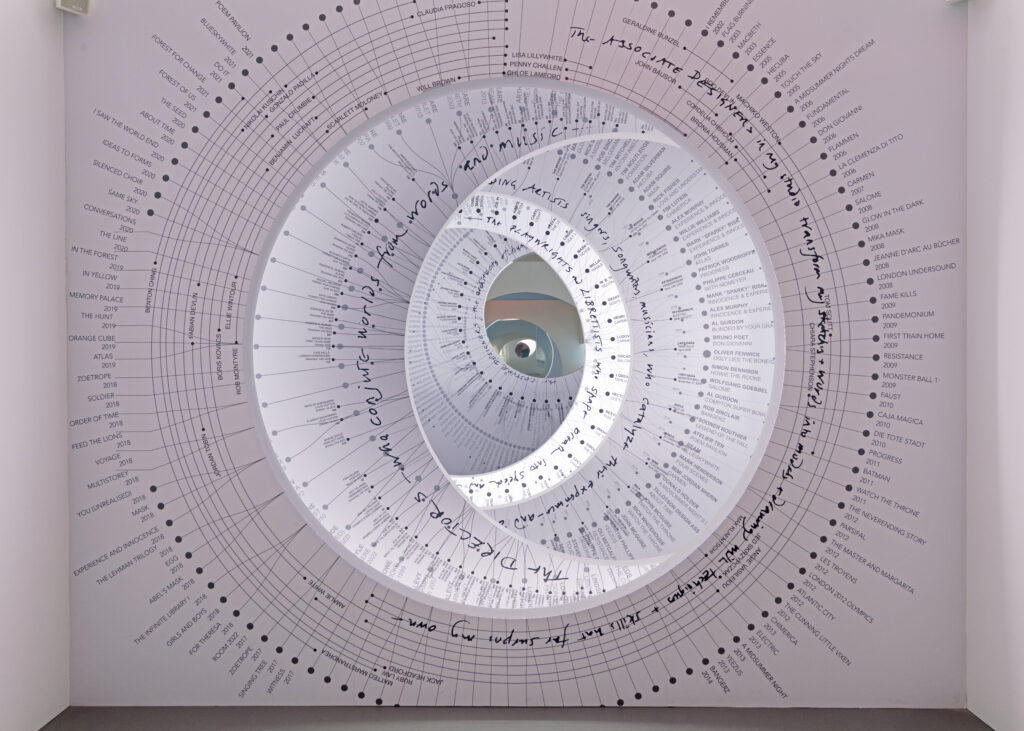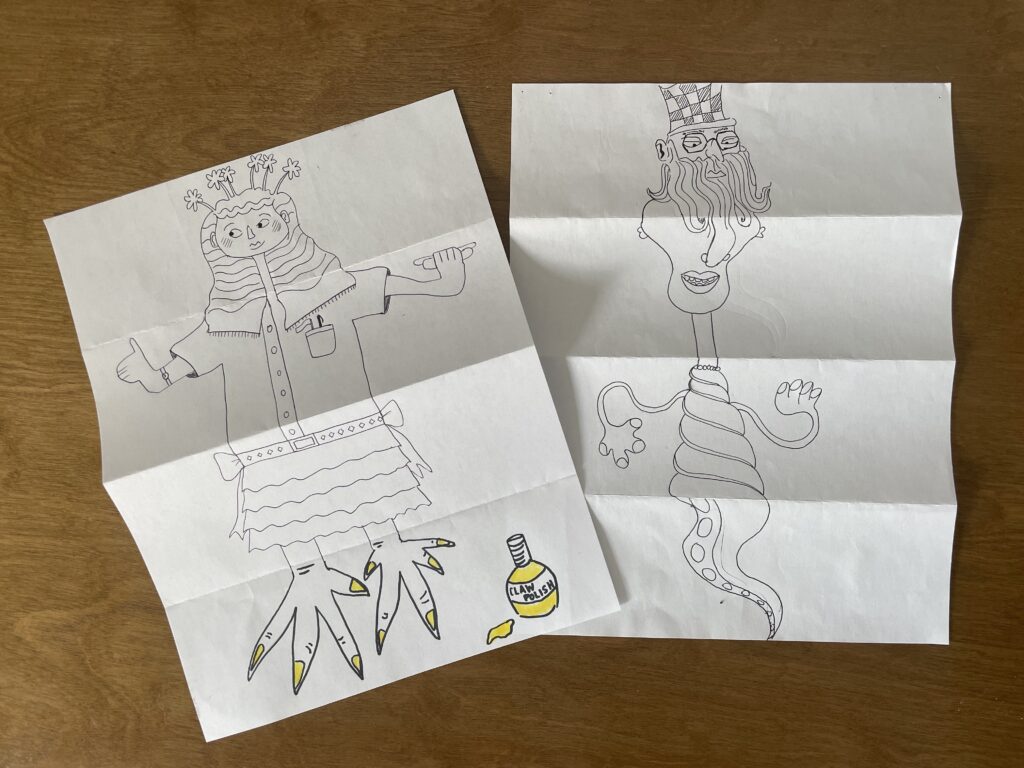MARCH: CREATIVE COLLABORATION

Collaboration is essential to Es Devlin’s artistic practice. Directors, studio associates, lighting designers, production managers, musicians, video designers, writers, fabricators, and more enrich her work and make it possible at such a grand scale. Some collaborations might last a few months while others endure for many years. All of them unfold over a continued conversation. No one person always has the best idea, and exchanging ideas fosters stronger outcomes.
While Devlin’s collaborations often have an end goal, much of the richness of working with others comes from the places you explore together along the way—the dead ends, the abandoned ideas, the miscommunications, the fresh starts. Working with someone offers a chance to consider new ways of thinking, and that exchange can inspire new directions for creative work. The exercises and materials on this page offer some ways to kickstart or reflect on collaboration in your own life. What might you learn from one collaboration that you apply to the next?
Table of Contents
- Prompts: Quick writing or visual activities
- Exercises: Activities that might ask you to spend a little more time
- Related Reading: Highlights from Cooper Hewitt, Smithsonian Design Library
- Programs: Exhibition tours, lectures, and hands-on workshops for visitors at all age and experience levels
PROMPTS
The prompt below is a quick activity to reflect on your own collaborative practice, inspired by the exhibition An Atlas of Es Devlin. This prompt is geared toward ages 15 and up, but all are welcome to try it out!
IRIS
One of the most rewarding aspects of collaboration comes from acknowledging all the individuals and groups that support us or work with us as we realize a project or goal. In the book and exhibition An Atlas of Es Devlin, Devlin names her collaborators on a layered iris, a shape she uses to express the overlaid perspectives of creative partners. The names of her projects and the people who made them possible surround large, overlapping circles.
Inspired by Devlin’s approach, we can acknowledge our own supporters in a similar way.

Es Devlin, Iris installation, “An Atlas of Es Devlin,” 2023 Photo: Elliot Goldstein © Smithsonian Institution
1. Make a list of projects you’ve worked on that challenged you. Your list might include creative projects or something you were required to do for work or school. Perhaps it includes things you’ve done around the house, for your family, or for fun. It might represent work you did last year or over many years.
2. Once you’ve written your list of projects, jot down the names of all your collaborators. Who helped you along the way? Try to be as inclusive as possible. You might include a teacher who advised you on a paper or a friend who was there for you during a low point in the project.
3. When you have written your list, think of how you might represent it visually. Maybe you want to follow Devlin’s example and draw or cut out circles and surround them with names. Perhaps you want to tape multiple sheets of paper together to form a giant timeline of projects and people who’ve supported you. Maybe you want to link names and projects together with colorful lines, forming a network. Perhaps you’ll overlap names and words in an abstract cloud. No matter your approach, try to make your list visual.
4. Reflect on the visual you made. What does it say about the collaborations in your life? Write a paragraph or a page reflecting on your past collaborations and your hopes for those to come.
EXERCISES
Exercises are activities that might ask you to spend a little more time or to gather and play with some additional materials.
EXQUISITE CORPSE
Collaboration often sparks new ideas and jumpstarts creativity. Exquisite Corpse is a collaborative game first used by surrealist artists in the 1920s. Players would contribute a word or drawing to a shared sheet of paper without seeing what players had added prior. The steps below will allow you and a partner or group to generate an elaborate and whimsical drawing sure to start a conversation. Grab a few friends, family members, or co-workers and see what comes out of this creative collaboration.
Steps
1. Start with a blank sheet of paper and fold it into four equal sections.
2. Draw or collage the head of your person, character, or creature on the top section.
3. Extend the lines of your corpse’s neck over the fold into the next section, so the next person knows where to continue from. Fold over the top section so the second person can’t see it and pass it to them.
4. The second person draws the shoulders and torso of the corpse, again extending the lines over the fold into the next section. Fold the second section and pass it to the next person.
5. The third person draws the waist of the corpse. Extend the lines and fold over the section and pass it to the last person.
6. The fourth person draws the legs and feet of the corpse.
7. Unfold all sections of the paper and reveal your collaborative corpse.
You can also fold the paper into three sections, where one person draws the head, the second person draws the torso and waist, and the third person draws the legs and feet. You can even consider increasing the folds and breaking up the figure even further.

Drawing Prompts
You can try this drawing technique with other prompts:
Draw a new animal species:
Try combining body parts of different animal species such as a bird, fish, reptile, amphibian, and insect. Be open to creating a unique creature and combining features. Maybe your animal has two heads or perhaps you draw a lion’s lower body with a shark tail.
Design an object:
Create a new object for everyday use. For example, design a chair where the first person designs the back rest, the second designs the seat, and the third designs the legs. Other objects you can design as a group might include vases or lamps. Explore Cooper Hewitt’s collection for inspiration.
Design an environment:
For this prompt, turn your paper horizontally. Inspired by Es Devlin, design a new environment. You can set parameters and design a room or stage or even draw a whole new imaginary world. You can fold the paper as many times as you please.
Writing Prompts
You can also try this activity with other creative forms. You could write a poem, story, or even music with a small group of people. Just as the figures above are divided into sections, decide what each person will contribute and think about what information will be shared between participants. For example, for a poem, each person might contribute a line of text. Only the previous line would be shared with the next participant to make the overall poem a surprise.

RELATED READING
FROM Cooper Hewitt, Smithsonian Design Library
Cooper Hewitt, Smithsonian Design Museum’s Library contains more than 100,000 volumes, including books, periodicals, catalogues, and trade literature dating from the fifteenth through the twentieth centuries. Explore a highlight below that illustrates an intricate example of Exquisite Corpse and try out the game yourself in the exercise above.
The Conversation, by Jean Michel Folon and Milton Glaser
American graphic designer Milton Glaser and Belgian artist, illustrator, and sculptor Jean-Michel Folon celebrated their long friendship in a book collaboration titled, The Conversation. Despite a language barrier, the two worked together on this elaborate Exquisite Corpse.

PAST PROGRAMS
Cooper Hewitt hosts a range of programs—including exhibition tours, lectures, hands-on workshops, and others—for visitors at all age and experience levels.

